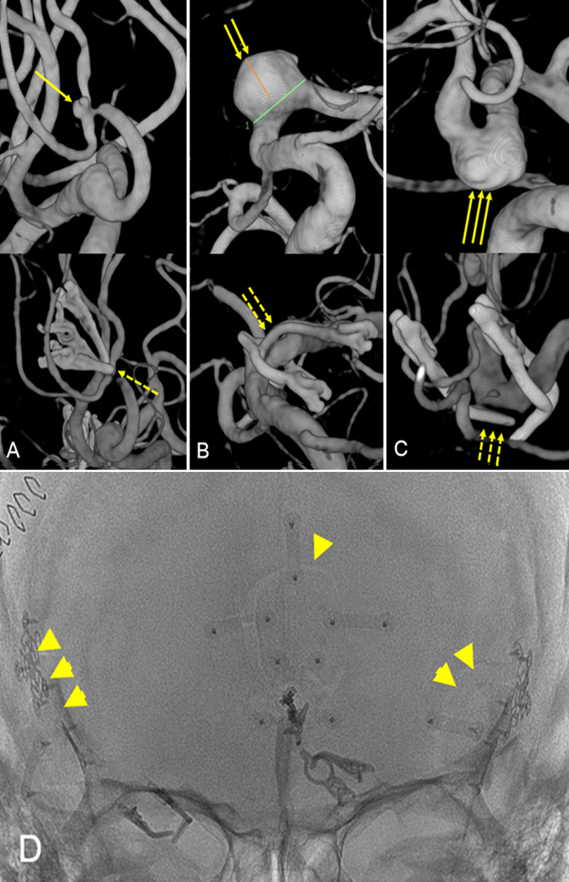Multiple cerebral aneurysm surgery, keyhole approaches are safe and effective
-First published results of multiple unruptured intracranial aneurysms (UIAs) surgery via the keyhole approaches
-Seoul National University Hospital Dept of Neurosurgery: “Excellent treatment results, minimal complications and side effects”
A new study has found that the keyhole approach in which a small hole in the head is used is very effective and safe for the treatment of multiple cerebral aneurysms. As well as reducing the burden on patients, it is expected to become a new paradigm for the treatment of cerebral aneurysms.
Professor Cho Won-Sang's team at Seoul National University Hospital Dept of Neurosurgery performed keyhole approaches on 493 patients from 2013 to 2018. As a result of analyzing the complications and risk factors of 110 patients with Multiple unruptured intracranial aneurysms (UIAs), the success rate of ligation of cerebral aneurysms was superior to that of the conventional method, and complications and operation time were significantly reduced.
A cerebral aneurysm is a vascular disease in which microscopic cracks in the walls of blood vessels in the brain form and abnormally swell. The prevalence is estimated to be at least 3% of the total population. When a cerebral blood vessel ruptures or enlarges and compresses the surrounding nerve structures, it causes neurologically fatal abnormalities. It is known that one in three patients who suffer cerebral aneurysms experience two or more multiple cerebral aneurysms, and the risk of rupture is 2-3 times higher than that of experiencing a single cerebral aneurysm.

There are two typical treatment methods for cerebral aneurysms: operation and procedure. The operation method is a craniotomy and clip ligation in which the incision of the scalp is made, the skull is opened, and the swollen cerebral aneurysm is treated with a clip. The procedure method refers to coil embolization in which a micro-catheter is inserted into a peripheral blood vessel of a leg or arm, and the coil is filled in the cerebral aneurysm by accessing the cerebral blood vessel.
If there is only one cerebral aneurysm that needs treatment, general anesthesia and surgery or procedure are performed. The best thing is to treat the whole thing without complications in one go under anesthesia but in most cases, surgery and procedures are repeated many times under general anesthesia. The burdens of such treatment, such as time, cost, and risk, increases.
The team used a minimally invasive craniotomy called the keyhole approach. We focused on the fact that the size of keyhole craniotomy is significantly smaller than existing craniotomy by 3 cm. Depending on the location of the cerebral aneurysm, the cerebral aneurysms at different locations were approached and ligated via 1 to 3 small bone holes (keyholes). It has succeeded in treating multiple cerebral aneurysms with only one placement under general anaesthesia and one skin incision. Results of single cerebral aneurysm treatment using the keyhole approach have been reported by various institutions around the world, but this is the first time to report treatment results for multiple aneurysms in different locations.
The keyhole approach had a satisfactory ligation rate of 97%, and permanent complications such as cerebral infarction and cerebral haemorrhage were only 1.8%. Considering that the satisfactory treatment rate for single cerebral aneurysm surgery or procedure reported by leading foreign institutions is about 80% to 90% and complications from 3% to 14%, the treatment outcomes in this study are better.
It is relatively well known that cerebral aneurysm ligation using the keyhole approach produces almost no bleeding, is cosmetically superior, and minimizes anaesthesia-related complications due to its short operation time compared to conventional surgical methods. However, the operation space for it is narrow and deep, and the difficulty of the operation is high, and it is not widely practised because it requires a lot of experience.
Professor Cho Won-Sang said, "The keyhole approach overcomes the shortcomings of existing treatments, reduces complications, and gives the best treatment results to patients." He also expected, "With the keyhole approach, we have performed cavernous angioma surgery as well as cerebral aneurysm surgery more than 1,000 times. This experience will help treat patients with cerebrovascular disease."
This study, which revealed the clinical results of multiple cerebral aneurysm surgery using the keyhole approach for the first time, was published online in the latest issue of the Journal of Neurosurgery, the official journal of the American Academy of Neurosurgery.